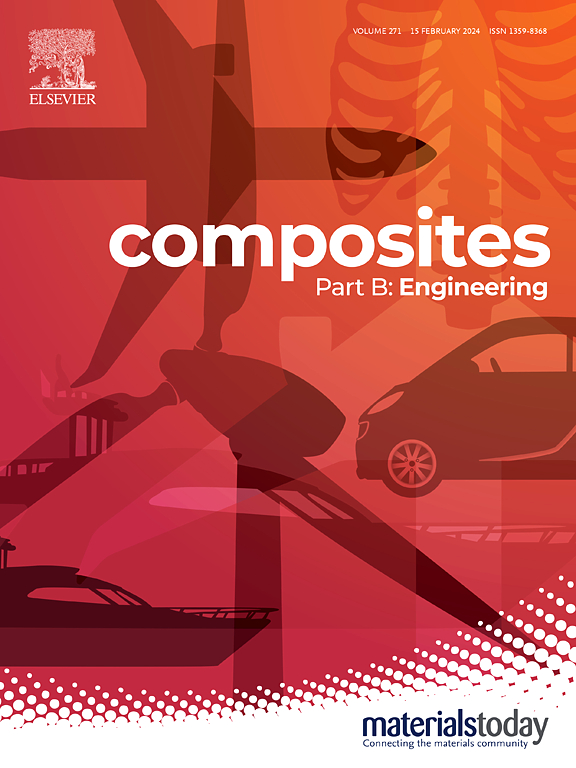Low dielectric and high thermal conductivity polyimide nanocomposites with fully closed-loop recycling and highly consistent healing
IF 12.7
1区 材料科学
Q1 ENGINEERING, MULTIDISCIPLINARY
引用次数: 0
Abstract
Multifunctional Polyimide (PI) with low dielectric and high thermal conductivity are widely utilized in high-signal-frequency and high-integration electronic devices, yet they are vulnerable to damage within complex operating environments. The development of such high-performance multifunctional composites with recyclable and repairable capability has represented significant challenges. Herein, novelty supramolecular PI nanocomposites comprising Schiff base bonds and hydron bonding interactions via amino-terminated polyimide, functionalized boron nitride nanosheets and aldehyde-containing crosslinking agents maintain the inherent high thermal stability and tensile strength of conventional PI and demonstrate fully closed-loop pH-adjusted liquid-level and high-purity powder-level recyclability, as well as superior healing ability after various mechanical or electrical damage. The resultant PI nanocomposite exhibits notable comprehensive performance, with high recycled in-plane and through-plane thermal conductivity of 8.69 and 5.44 W m−1 K−1, low recycled dielectric constant of 2.98 at 1 MHz and excellent healed dielectric breakdown strength of 378.9 kV mm−1, as well as high recovery rates. Furthermore, the repairable triboelectric nanogenerator based on the PI nanocomposite exhibits excellent shape tailorability and nearly-consistent output electrical performance. The concepts presented in this paper offer practical solutions for sustainable high-performance electronic materials and shed light on the integrated structural design of green nanocomposites.

低介电和高导热聚酰亚胺纳米复合材料具有完全闭环回收和高度一致的愈合
多功能聚酰亚胺(PI)具有低介电和高导热的特点,广泛应用于高信号频率和高集成度的电子器件中,但在复杂的工作环境中容易受到损伤。这种具有可回收和可修复能力的高性能多功能复合材料的发展面临着重大挑战。本文中,新型超分子PI纳米复合材料通过氨基端聚亚胺、功能化氮化硼纳米片和含醛交联剂组成希夫碱键和氢键相互作用,保持了传统PI固有的高热稳定性和抗拉强度,并表现出完全闭环的ph调节液位和高纯度粉末级可回收性,以及在各种机械或电气损伤后的优异愈合能力。所制得的PI纳米复合材料综合性能优异,具有较高的面内和透面热导率,分别为8.69和5.44 W m−1 K−1,1 MHz时低的再循环介电常数为2.98,良好的愈合介电击穿强度为378.9 kV mm−1,回收率高。此外,基于PI纳米复合材料的可修复摩擦电纳米发电机具有优异的形状可定制性和几乎一致的输出电性能。本文提出的概念为可持续高性能电子材料提供了实用的解决方案,并为绿色纳米复合材料的整体结构设计提供了思路。
本文章由计算机程序翻译,如有差异,请以英文原文为准。
求助全文
约1分钟内获得全文
求助全文
来源期刊

Composites Part B: Engineering
工程技术-材料科学:复合
CiteScore
24.40
自引率
11.50%
发文量
784
审稿时长
21 days
期刊介绍:
Composites Part B: Engineering is a journal that publishes impactful research of high quality on composite materials. This research is supported by fundamental mechanics and materials science and engineering approaches. The targeted research can cover a wide range of length scales, ranging from nano to micro and meso, and even to the full product and structure level. The journal specifically focuses on engineering applications that involve high performance composites. These applications can range from low volume and high cost to high volume and low cost composite development.
The main goal of the journal is to provide a platform for the prompt publication of original and high quality research. The emphasis is on design, development, modeling, validation, and manufacturing of engineering details and concepts. The journal welcomes both basic research papers and proposals for review articles. Authors are encouraged to address challenges across various application areas. These areas include, but are not limited to, aerospace, automotive, and other surface transportation. The journal also covers energy-related applications, with a focus on renewable energy. Other application areas include infrastructure, off-shore and maritime projects, health care technology, and recreational products.
 求助内容:
求助内容: 应助结果提醒方式:
应助结果提醒方式:


